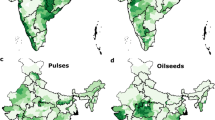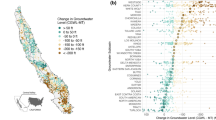Abstract
Global groundwater resources are under strain, with cascading effects on producers, food and fibre production systems, communities and ecosystems. Investments in biophysical research have clarified the challenges, catalysed a proliferation of technological solutions and supported incentivizing individual irrigators to adjust practices. However, groundwater management is fundamentally a governance challenge. The reticence to prioritize building governance capacity represents a critical ‘blind spot’ contributing to a low return on investment for research funding with negative consequences for communities moving closer towards resource depletion. In this Perspective, we recommend shifts in research, extension and policy priorities to build polycentric governance capacity and strategic planning tools, and to re-orient priorities to sustaining aquifer-dependent communities in lieu of maximizing agricultural production at the scale of individual farm operations. To achieve these outcomes, groundwater governance needs to be not only prioritized but also democratized.
This is a preview of subscription content, access via your institution
Access options
Subscribe to this journal
Receive 12 digital issues and online access to articles
$99.00 per year
only $8.25 per issue
Buy this article
- Purchase on Springer Link
- Instant access to full article PDF
Prices may be subject to local taxes which are calculated during checkout

Similar content being viewed by others
References
Döll, P. et al. Impact of water withdrawals from groundwater and surface water on continental water storage variations. J. Geodyn. 59–60, 143–156 (2012).
Dieter, C. A. et al. Estimated Use Of Water in the United States in 2015 US Geological Survey Circular 1441 (USGS, 2018); https://doi.org/10.3133/cir1441
Siebert, S., Ewert, F., Eyshi Rezaei, E., Kage, H. & Grass, R. Impact of heat stress on crop yield—on the importance of considering canopy temperature. Environ. Res. Lett. 9, 044012 (2014).
Stephan, M., Marshall, G. & McGinnis, M. in Governing Complexity: Analyzing and Applying Polycentricity (eds Thiel, A. et al.) 21–44 (Cambridge Univ. Press, 2019); https://doi.org/10.1017/9781108325721.002
Steward, D. R. et al. Tapping unsustainable groundwater stores for agricultural production in the High Plains Aquifer of Kansas, projections to 2110. Proc. Natl Acad. Sci. USA 110, E3477–E3486 (2013).
Haacker, E. M. K., Kendall, A. D. & Hyndman, D. W. Water level declines in the High Plains Aquifer: predevelopment to resource senescence. Groundwater 54, 231–242 (2016).
Russo, T. A. & Lall, U. Depletion and response of deep groundwater to climate-induced pumping variability. Nat. Geosci. 10, 105–108 (2017).
Scanlon, B. R. et al. Groundwater depletion and sustainability of irrigation in the US High Plains and Central Valley. Proc. Natl Acad. Sci. USA 109, 9320–9325 (2012).
Hrozencik, R. A., Manning, D. T., Suter, J. F., Goemans, C. & Bailey, R. T. The heterogeneous impacts of groundwater management policies in the Republican River Basin of Colorado. Water Resour. Res. 53, 10757–10778 (2017).
Colaizzi, P. D., Gowda, P. H., Marek, T. H. & Porter, D. O. Irrigation in the Texas High Plains: a brief history and potential reductions in demand. Irrig. Drain. 58, 257–274 (2009).
Lyle, W. M. & Bordovsky, J. P. LEPA corn irrigation with limited water supplies. Trans. ASAE 38, 455–462 (1995).
Chen, Y. et al. Assessment of alternative agricultural land use options for extending the availability of the Ogallala Aquifer in the Northern High Plains of Texas. Hydrology 5, 53 (2018).
Rudnick, D. R. et al. Deficit irrigation management of maize in the High Plains Aquifer Region: a review. JAWRA J. Am. Water Resour. Assoc. 55, 38–55 (2019).
Hao, B. et al. Grain yield, evapotranspiration, and water-use efficiency of maize hybrids differing in drought tolerance. Irrig. Sci. 37, 25–34 (2019).
Chiara, C. & Marco, M. Irrigation efficiency optimization at multiple stakeholders’ levels based on remote sensing data and energy water balance modelling. Irrig. Sci. https://doi.org/10.1007/s00271-022-00780-4 (2022).
Schwartz, R. C., Bell, J. M., Colaizzi, P. D., Baumhardt, R. L. & Hiltbrunner, B. A. Response of maize hybrids under limited irrigation capacities: crop water use. Agron. J. https://doi.org/10.1002/agj2.21011 (2022).
Taghvaeian, S. et al. Irrigation scheduling for agriculture in the United States: the progress made and the path forward. Trans. ASABE 63, 1603–1618 (2020).
Sears, L. et al. Jevons’ paradox and efficient irrigation technology. Sustainability 10, (2018).
Mpanga, I. K. & Idowu, O. J. A decade of irrigation water use trends in Southwestern USA: the role of irrigation technology, best management practices, and outreach education programs. Agric. Water Manag. 243, 106438 (2021).
Grafton, R. Q. et al. The paradox of irrigation efficiency. Science 361, 748–750 (2018).
Cook, C. & Bakker, K. Water security: debating an emerging paradigm. Glob. Environ. Change 22, 94–102 (2012).
Brewis, A. et al. Household water insecurity is strongly associated with food insecurity: evidence from 27 sites in low‐and middle‐income countries. Am. J. Hum. Biol. 32, e23309 (2020).
Rosinger, A. Y. & Young, S. L. The toll of household water insecurity on health and human biology: current understandings and future directions. Wiley Interdiscip. Rev. Water 7, e1468 (2020).
London, J. K. et al. Disadvantaged unincorporated communities and the struggle for water justice in California. Water Altern. 14, 520–545 (2021).
Hanak, E. et al. Water and the future of the San Joaquin Valley. Public Policy Inst. Calif. 100, (2019).
Lauer, S. et al. Values and groundwater management in the Ogallala Aquifer region. J. Soil Water Conserv. 73, 593–600 (2018).
Edwards, E. C. & Guilfoos, T. The economics of groundwater governance institutions across the globe. Appl. Econ. Perspect. Policy 43, 1571–1594 (2021).
MacLeod, C. & Méndez-Barrientos, L. E. Groundwater management in California’s Central Valley: a focus on disadvantaged communities. Case Stud. Environ. 3, 1–13 (2019).
Méndez-Barrientos, L. E. et al. Farmer participation and institutional capture in common-pool resource governance reforms. The case of groundwater management in California. Soc. Nat. Resour. 33, 1486–1507 (2020).
Blythe, J. et al. The dark side of transformation: latent risks in contemporary sustainability discourse. Antipode 50, 1206–1223 (2018).
Lubell, M. Governing institutional complexity: the ecology of games framework. Policy Stud. J. 41, 537–559 (2013).
Berardo, R. & Lubell, M. The ecology of games as a theory of polycentricity: recent advances and future challenges. Policy Stud. J. 47, 6–26 (2019).
Ostrom, E. Understanding Institutional Diversity (Princeton Univ. Press, 2009).
Ostrom, E. & Basurto, X. Crafting analytical tools to study institutional change. J. Inst. Econ. 7, 317–343 (2011).
Lubell, M. & Morrison, T. H. Institutional navigation for polycentric sustainability governance. Nat. Sustain. 4, 664–671 (2021).
Lauer, S. & Sanderson, M. R. Producer attitudes toward groundwater conservation in the U.S. Ogallala-High Plains. Groundwater 58, 674–680 (2020).
Niles, M. T. & Wagner, C. R. H. The carrot or the stick? Drivers of California farmer support for varying groundwater management policies. Environ. Res. Commun. 1, 45001 (2019).
Evans, R. G. & King, B. A. Site-specific sprinkler irrigation in a water-limited future. Trans. ASABE 55, 493–504 (2012).
Sanderson, M. R. & Hughes, V. Race to the bottom (of the well): groundwater in an agricultural production treadmill. Soc. Probl. 66, 392–410 (2018).
Ostrom, E. The challenge of common-pool resources. Environ. Sci. Policy Sustain. Dev. 50, 8–21 (2008).
Agriculture Innovation Agenda (USDA, 2021); https://www.usda.gov/aia
Partnerships for climate-smart commodities. USDA https://www.usda.gov/climate-solutions/climate-smart-commodities (2022).
Closas, A. & Molle, F. Chronicle of a demise foretold: state vs. local groundwater management in Texas and the High Plains aquifer system. Water Altern. 11, 511–532 (2018).
Lubell, M., Blomquist, W. & Beutler, L. Sustainable groundwater management in California: a grand experiment in environmental governance. Soc. Nat. Resour. 33, 1447–1467 (2020).
Roberts, M., Milman, A. & Blomquist, W. in Water Resilience (eds Baird, J. & Plummer, R.) 41–63 (Springer, Cham., 2021).
Megdal, S. B. The role of the public and private sectors in water provision in Arizona, USA. Water Int. 37, 156–168 (2012).
Desired future conditions. Texas Water Development Board https://www.twdb.texas.gov/groundwater/dfc/index.asp (2022).
Schoengold, K. & Brozovic, N. The future of groundwater management in the High Plains: evolving institutions, aquifers and regulations. in. West. Econ. Forum 16, 47–53 (2018).
Factsheet H.B. 2056/S.B. 1368 (Arizona State Senate, 2021); https://www.azleg.gov/legtext/55leg/1R/summary/S.2056-1368NREW_ASENACTED.pdf
Local enhanced management areas; establishment procedures; duties of chief engineer; hearing; notice; orders; review. Kansas Office of Revisor of Statutes http://www.ksrevisor.org/statutes/chapters/ch82a/082a_010_0041.html (2012).
Deines, J. M., Kendall, A. D., Butler, J. J. & Hyndman, D. W. Quantifying irrigation adaptation strategies in response to stakeholder-driven groundwater management in the US High Plains Aquifer. Environ. Res. Lett. 14, 044014 (2019).
California Department of Water Resources. Sustainable Groundwater Management Act (SGMA) (State of California, 2022); https://water.ca.gov/programs/groundwater-management/sgma-groundwater-management
Ayres, A. B., Edwards, E. C. & Libecap, G. D. How transaction costs obstruct collective action: the case of California’s groundwater. J. Environ. Econ. Manag. 91, 46–65 (2018).
Dobbin, K. B. & Lubell, M. Collaborative governance and environmental justice: disadvantaged community representation in California sustainable groundwater management. Policy Stud. J. 49, 562–590 (2021).
Bruno, E. M., Hagerty, N. & Wardle, A. R. The Political Economy of Groundwater Management: Descriptive Evidence from California (National Bureau of Economic Research, 2022).
Cody, K. C., Smith, S. M., Cox, M. & Andersson, K. Emergence of collective action in a groundwater commons: irrigators in the San Luis Valley of Colorado. Soc. Nat. Resour. 28, 405–422 (2015).
Perez-Quesada, G. & Hendricks, N. P. Lessons from local governance and collective action efforts to manage irrigation withdrawals in Kansas. Agric. Water Manag. 247, 106736 (2021).
Bopp, C., Engler, A., Jara-Rojas, R., Hunecke, C. & Melo, O. Collective actions and leadership attributes: a cluster analysis of water user associations in Chile. Water Econ. Policy 8, 2250003 (2022).
Morrison, T. H. et al. The black box of power in polycentric environmental governance. Glob. Environ. Change 57, 101934 (2019).
Bitterman, P., Bennett, D. A. & Secchi, S. Constraints on farmer adaptability in the Iowa-Cedar River Basin. Environ. Sci. Policy 92, 9–16 (2019).
Butler, J. J. Jr., Whittemore, D. O., Wilson, B. B. & Bohling, G. C. Sustainability of aquifers supporting irrigated agriculture: a case study of the High Plains aquifer in Kansas. Water Int. 43, 815–828 (2018).
Zwart, S. J. & Bastiaanssen, W. G. M. Review of measured crop water productivity values for irrigated wheat, rice, cotton and maize. Agric. Water Manag. 69, 115–133 (2004).
Du, Y.-D. et al. Crop yield and water use efficiency under aerated irrigation: a meta-analysis. Agric. Water Manag. 210, 158–164 (2018).
Zheng, H. et al. Water productivity of irrigated maize production systems in Northern China: a meta-analysis. Agric. Water Manag. 234, 106119 (2020).
Crouch, M., Guerrero, B., Amosson, S., Marek, T. & Almas, L. Analyzing potential water conservation strategies in the Texas Panhandle. Irrig. Sci. 38, 559–567 (2020).
Acknowledgements
This work was supported by USDA National Institute of Food and Agriculture award #2016-68007-25066, the National Science Foundation award #1650042, and the Ogallala Aquifer Program. We thank the full Ogallala Water project team, advisory board and engaged participants for their numerous contributions (www.ogallalawater.org).
Author information
Authors and Affiliations
Corresponding author
Ethics declarations
Competing interests
The authors declare no competing interests.
Peer review
Peer review information
Nature Water thanks Eric Edwards and Sharon Megdal for their contribution to the peer review of this work.
Additional information
Publisher’s note Springer Nature remains neutral with regard to jurisdictional claims in published maps and institutional affiliations.
Rights and permissions
Springer Nature or its licensor (e.g. a society or other partner) holds exclusive rights to this article under a publishing agreement with the author(s) or other rightsholder(s); author self-archiving of the accepted manuscript version of this article is solely governed by the terms of such publishing agreement and applicable law.
About this article
Cite this article
Schipanski, M.E., Sanderson, M.R., Méndez-Barrientos, L.E. et al. Moving from measurement to governance of shared groundwater resources. Nat Water 1, 30–36 (2023). https://doi.org/10.1038/s44221-022-00008-x
Received:
Accepted:
Published:
Issue Date:
DOI: https://doi.org/10.1038/s44221-022-00008-x
This article is cited by
-
Greenhouse gas emissions from US irrigation pumping and implications for climate-smart irrigation policy
Nature Communications (2024)
-
Weather whiplash events in Europe and North Atlantic assessed as continental-scale atmospheric regime shifts
npj Climate and Atmospheric Science (2023)
-
Wavelet gated multiformer for groundwater time series forecasting
Scientific Reports (2023)
-
Thousands of domestic and public supply wells face failure despite groundwater sustainability reform in California’s Central Valley
Scientific Reports (2023)
-
Measuring water from space
Nature Water (2023)



